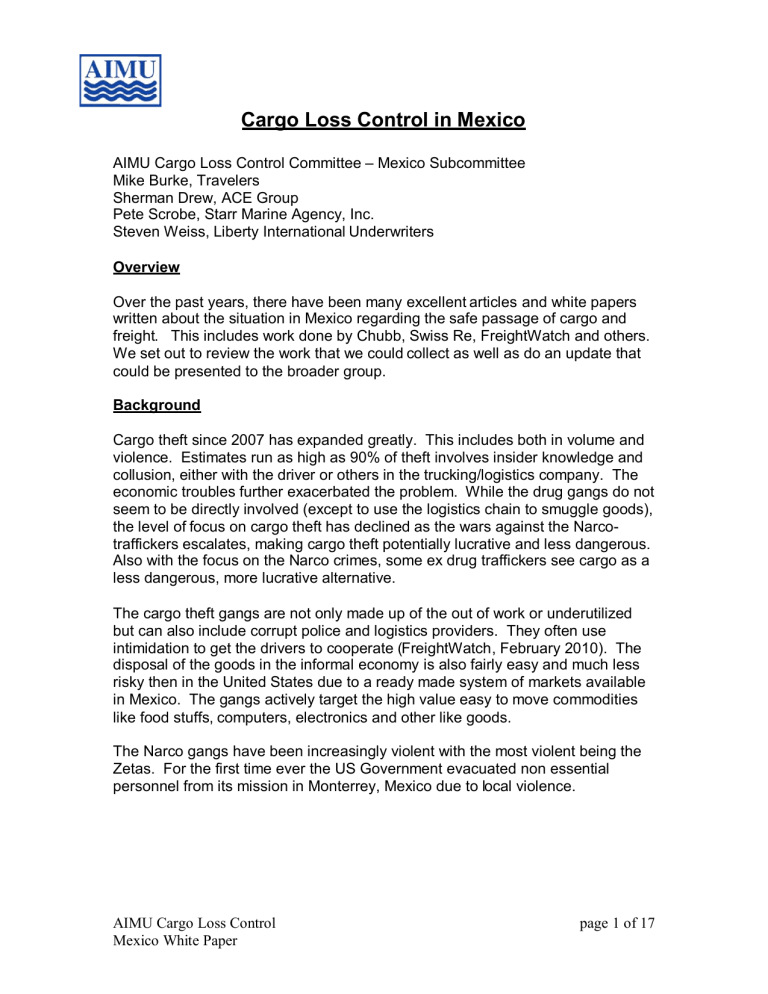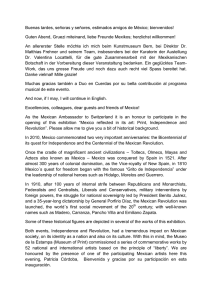
Cargo Loss Control in Mexico AIMU Cargo Loss Control Committee – Mexico Subcommittee Mike Burke, Travelers Sherman Drew, ACE Group Pete Scrobe, Starr Marine Agency, Inc. Steven Weiss, Liberty International Underwriters Overview Over the past years, there have been many excellent articles and white papers written about the situation in Mexico regarding the safe passage of cargo and freight. This includes work done by Chubb, Swiss Re, FreightWatch and others. We set out to review the work that we could collect as well as do an update that could be presented to the broader group. Background Cargo theft since 2007 has expanded greatly. This includes both in volume and violence. Estimates run as high as 90% of theft involves insider knowledge and collusion, either with the driver or others in the trucking/logistics company. The economic troubles further exacerbated the problem. While the drug gangs do not seem to be directly involved (except to use the logistics chain to smuggle goods), the level of focus on cargo theft has declined as the wars against the Narcotraffickers escalates, making cargo theft potentially lucrative and less dangerous. Also with the focus on the Narco crimes, some ex drug traffickers see cargo as a less dangerous, more lucrative alternative. The cargo theft gangs are not only made up of the out of work or underutilized but can also include corrupt police and logistics providers. They often use intimidation to get the drivers to cooperate (FreightWatch, February 2010). The disposal of the goods in the informal economy is also fairly easy and much less risky then in the United States due to a ready made system of markets available in Mexico. The gangs actively target the high value easy to move commodities like food stuffs, computers, electronics and other like goods. The Narco gangs have been increasingly violent with the most violent being the Zetas. For the first time ever the US Government evacuated non essential personnel from its mission in Monterrey, Mexico due to local violence. AIMU Cargo Loss Control Mexico White Paper page 1 of 17 FreightWatch publishes the above cargo theft incident map of Mexico. This is quarter one 2010 Purpose The underlying reason for the writing of this paper is to summarize all of the extensive information available and to offer some (mostly time tested) methods of working in this environment. Underwriters need to be aware of the true situation and take proactive methods to avoid or minimize their exposure. Review of the information noted in the Bibliography will also give additional information and insight. AIMU Cargo Loss Control Mexico White Paper page 2 of 17 Statistics These are drawn from the FreightWatch First Quarter 2010 report Cargo theft in Mexico by geographic (state) location: Mexico State: Jalisco Coahuila Queretaro Guanajuato Nueva Leon Baja California Sinaloa Tamaulipas Campeche Veracruz Colima Zacatecas 8 (includes Mexico City) 8 6 6 4 4 4 4 3 3 3 2 2 st These are drawn from the FreightWatch 1 quarter 2010 report AIMU Cargo Loss Control Mexico White Paper page 3 of 17 Cargo theft in Mexico by logistics location: Roadside – Truck stop – Secured DC/Terminal lot – Unsecured DC/Terminal lot – Public Access Parking - 76% 16% 3% 3% 2% st These are drawn from the FreightWatch 1 quarter 2010 report AIMU Cargo Loss Control Mexico White Paper page 4 of 17 Cargo Theft by Commodity: Food/Drinks Misc Building/Industrial Auto Parts Clothing/Shoes Home/Garden Electronics Pharmaceuticals Consumer Care Alcohol 26% 17% 15% 11% 9% 8% 6% 5% 2% 1% st These are drawn from the FreightWatch 1 quarter 2010 report Statistics Summary The main thing to take from the statistics is the opportunistic aspect (roadside and truck stop) and focus on things easily sold on the black market. Over 90% of the thefts occurred on the road. The ease of sale of these commodities is the key to there theft. How the criminals know where to target is of course one of the items addressed herein. AIMU Cargo Loss Control Mexico White Paper page 5 of 17 What Is The Current Cargo Security Situation In Mexico? Based on a number of reliable sources Cargo Crime in Mexico is bad and getting worse every day. FreightWatch in Mexico reports that border towns do not present a significant exposure but the closer you get to Mexico City the worse it gets. Specific areas of concern include Puebla and Toluca amongst the many hot spots bordering Mexico City. According to the latest FreightWatch Report: “Mexico consistently rates as one of the riskiest countries in the world for cargo security”. FreightWatch notes: In the first quarter of 2010, the state of Guanajuato had the highest rates of cargo theft outside of the Distrito Federal. The northern states also suffered an increase in cargo theft. During Q1 the riskiest cities included: Ciudad Juarez in the state of Chihuahua AIMU Cargo Loss Control Mexico White Paper page 6 of 17 Ciudad Juarez in the state of Chihuahua Monterrey in Nuevo Leon AIMU Cargo Loss Control Mexico White Paper page 7 of 17 Nuevo Laredo, Reynosa, Tampico and Cd. Victoria in the state of Tamaulipas Torreon, Saltillo and Monclova in the state of Coahuila AIMU Cargo Loss Control Mexico White Paper page 8 of 17 The two most dangerous highways in the northern region are the TorreonSaltillo and Monterrey-Reynosa. Other cargo theft incidents occurred on roads that connect with ports; the port of Veracruz, Manzanillo and Lazaro Cardenas experience an increase in the number of cargo thefts during Q1. FreightWatch International, a leader in logistics security solutions, publishes regular Security Assessments & Intelligence reports designed to raise awareness and understanding of Supply Chain’s vulnerabilities throughout the world. A number of other sources validate the continued problems in Mexico. For instance a recent article in the Latin Business Chronicle cites that Cargo theft is a thriving business in Mexico and that just about any cargo is at risk. Electric appliances, food, clothing, shoes, car parts, medicines – whatever the product, there’s a bustling underground market ready to receive it and sell it to consumers, who are eager to buy name-brand items at rock bottom prices. They go on to report that in 2009, cargo theft in Mexico cost businesses between $650 million and $750 million, according to a recent estimate by the National Multimodal Transport Alliance (ANTM). This represents a 40% spike over the average of the past three years. In an excerpt from the McClatchy Washington Bureau, it states …highway and railway theft is a growth industry in Mexico. Train robberies occur on average of 4.5 times a day, and parts of Mexico are so rife with truck hijackings that one newspaper labeled them “Bermuda Triangle” an analogy to the Atlantic Ocean region bearing the same name where ships and planes mysteriously disappear. AIMU Cargo Loss Control page 9 of 17 Mexico White Paper According to a highway cargo trade group in Mexico, known as CANACAR, the National Chamber of Mexican Transportation (a trade association representing Mexican motor carriers) reported more than 10,000 highway thefts of cargo in 2009. This is a 40% increase over the previous year. No figures were available for 2010 at the time this article was published. Also noted in the article is the violent edge of cargo theft in Mexico where 60 to 65% of the thefts occurring are at gunpoint (Mexican Insurers Association). Unfortunately, drug trafficking increases the number of thefts and the level of violence during the theft hijackings. This is on top of the already high death toll directly related to drug trafficking (according to one local surveyor is more than 6,500 a year). This surveyor also shared an article authored by CANACAR which discusses how the cargo security problem is impacting auto transporters in Jalisco. This has forced carriers in Jalisco to raise their expenses 7% for safety on each trip. Still there have been 400 hijackings in this Jalisco so far this year (according to CANACAR). As a result, of the cargo security problem, the theft index has increased significantly in some municipalities in Jalisco like Zapopan, Tlacomulco and Tlaquepaque. Also insurers have been influenced to raise their rates 30% because of the lack of security. Comparing robbery rates 2008 to 2009 shows a 36% increase (220 in 2008 to 300 in 2009). And the trend is increasing gradually with higher incidence of full truckloads stolen from carrier’s yards. In a recent article published by SecurityInfoWatch.com, it is reported that issues pertaining to cargo theft have been on the rise in Mexico since 2005 when the government decided to crackdown on drug cartels in the country. The article goes on to report the Mexico has seen an average of 1,500 hijackings per year for the last five years. Further, it is estimated that 90% of cargo crime committed in Mexico is aided by driver or employee collusion. Who Are The Perpetrators? The Latin Business Chronicle in an article titled “Los Banditos Ride Again stated that throughout most of Mexico, Criminal gangs are the leading threat to the country’s supply-chain. The Drug Cartels and Gangs both freelance and organized (linked to organized crime) are strategically located at major intersections of internal, as well as international commerce. This view is consistent with other leading sources monitoring the cargo security problem. Their operations are coordinated and often perfectly timed, triggered by inside information about cargo shipments obtained from a variety of sources: truckers, warehouse workers, shipping agents and even government customs agents or inspectors. Most security experts close to Mexico situation indicate that the most aggressive gangs are operating in the center of the country, in the states of Mexico, Puebla, AIMU Cargo Loss Control Mexico White Paper page 10 of 17 Veracruz and Michoacan (in and around Mexico City). Indications are that federal highways in these states are often only lightly policed and the majority of truckers employ few, if any, security procedures or technologies, such as GPS devices, emergency panic buttons or armed-guard escorts. Their efforts are reinforced largely through “information flight” as the significant and common element to the continuing cargo security trends. As such all supply chain participants present a risk: drivers, dispatchers, law enforcement, warehouse personnel, etc. Intelligence gathering efforts by criminals have been robust The organized Drug Cartels: criminals both freelance and organized have regular sources for information about shipments and are not above using strong arm techniques and bribery in order to obtain information about shipments. Plagues A significant amount of the crime problems are rooted in the drug problems with the cartels battling it out with law enforcement backed by US support and funding aimed at the drug traffickers. This has led to an ongoing battle with the cartels and groups splintering off from the drug gangs in the chaos. This warfare has led to some of the smaller groups actually branching off into other lucrative organized crime activities as an effort to diversify. This has led to a massive interconnected crime activity which presents a challenging environment for effective operation of the supply chain. AIMU Cargo Loss Control Mexico White Paper page 11 of 17 An extensive black market supports easy fencing of stolen products. With Mexican law enforcement tied up attacking drug cartels, free-lance crime gangs have become more daring and sophisticated hijacking trucks and trains and stealing massive loads of bulk products like steel, coffee, and beans. These gangsters armed with guns and equipped with heavy machinery are able to offload industrial materials and bulk agricultural goods and pass them to black market. An article in Whyprohibition.ca cites an incidence where Mexico’s 3rd largest steel producer, Altos Hornos de Mexico (AHMSA), has been the victim of nearly 40 robberies since January 2008 mostly along one stretch of deserted road in northern Mexico between the cities of Monterrey and Monclova. It is mentioned that thieves are capable of unloading a 30-ton roll of steel and find someone to buy it. The problems are compounded by the ever rising unemployment from the economic downturn in Mexico which has resulted in legions of young unemployed peoples looking for a means to support themselves. Mexico/USA Border Crossings The following is a discussion of the process of getting truck shipments from the United States to Mexico and vice versa. We will present the two scenarios, inbound to Mexico and inbound to the United States but in reality they are almost mirror images of each other. There are a total of 39 established border crossing points between the two countries with the main crossing into Mexico being as follows: Tijuana, Nogales, Juarez, Piedras Negras, Nueva Laredo, Matamoras. Refer to the slide show for locations Shipments into the United States We are using the border crossing at Nuevo Laredo as an illustration. The process will be identical no matter where the goods cross although there can be some differences as noted below. Logistics: 1- The long haul drivers will transport their loads up to Kilometer 26, the beginning of the Customs Zone on the way to Nuevo Laredo/Laredo (Note- the Customs Zone in Reynosa is located at Km 30, in Nogales Km 258 and Km 70 in Chihuahua). At this point the drivers present the required shipping paperwork including the bill of lading and other documentation. 2- Once they are permitted to move on, the drivers then proceed to a trailer drop yard as directed by the trucking company or the Mexican Customs broker; there are a number of these facilities in/near the border crossing city. The drivers wait AIMU Cargo Loss Control Mexico White Paper page 12 of 17 there until the local dray and have their Clearance documents available. This could be between 1-4 days or more. 3- When the shipment is cleared to proceed to Customs at the border, a local dray driver, again either arranged by the trucking company or the Mexican Customs broker, takes the load to Mexican Export Customs and then through U.S. Import Customs. Here, and in most other border crossing locations, these are contiguous (however, Mexican Export Customs and U.S. Import Customs can be separated by as much as 5 miles as is the case in Nogales) with a lot of traffic coursing in what has been called the “Meat Grinder.” 4- When the dray driver passes through, he will drop the load at a designated trailer/drop lot on the U.S. side of the border. 5- The load will then be picked up by the long haul U.S. driver for delivery to the ultimate destination. Shipments into Mexico The reverse takes place with the shipment taken to the trailer/drop lot on the U.S. side of the border where it stays awaiting Customs clearance. Once released and authorized to proceed, a U.S. dray driver takes the load through U.S. Export Customs and Mexico Import Customs all the way to the assigned drop lot in/near the Mexican border city. At this point the long haul driver can pick up the trailer and deliver it to the consignee. U.S. dray carriers (border transfer carriers) can only travel within 26 kilometers of either side of the border. This results in increased handling and an uncertainty as to who is handling the cargo/truck. On Imports from Mexico into the USA are duty free. Therefore, trucks are seldom unloaded and inspected. The USA tends to x-ray trucks and use dogs to check for drugs, smuggled goods and people. On southbound shipments Mexico collects a Value Added Tax (VAT). Because the VAT is a large source of revenue for Mexico, Mexican Customs tend to be vigilant in inspecting shipments into Mexico, thus, resulting in more handling. Note, while USA carriers are required to carry some insurance, the Mexican carriers are not required to carry any insurance. Security While there appears to be some times when the cargo is at rest, the trailer/drop lots are fairly well secured and the only real exposure is either minor pilferage (no one would consider trying to take a full trailer load back into Mexico through Kilometer 26 checkpoint or back into the U.S.) or smuggling of contraband (this would be northbound only and could consist of drugs and/or humans). While security escorts can be hired to follow the shipment to the trailer/drop lots and “sit on them” during their stay, this is typically not done unless the shipper or consignee has concerns about the integrity of the shipment. AIMU Cargo Loss Control Mexico White Paper page 13 of 17 If necessary, there are consultants like FreightWatch Mexico, which can be engaged to handle escorting of trucks in transit for approximately US$1 per kilometer. They will also usually be an hourly/daily fee basis if they are asked to monitor a shipment while it is being staged at a trailer/drop lot. C-TPAT/NAFTA Contraband is being smuggled into the U.S. in cargo containers. Any carrier that is found with contraband can have their C-TPAT certification revoked by US Customs & Border Patrol. Under NAFTA, Mexican trucking companies were allowed to operate within a radius of the US border, but this was recently revoked by the US for 250 Mexican Trucking companies (reportedly for safety reasons?) in response to pressure from American trade unions. All of these 250 trucking companies could cross the border and were C-TPAT certified Cargo must now be handed off at the border to US trucking companies, which results in additional delays and hence exposure at the border crossings, which are hot spots for cargo theft. Legal issues One of the additional problems in Mexico is the low limitation of liability of truckers. Attorneys have advised that even when the trucker does not follow specific instructions (such as to hire a guard or follow a safe route – see map below), the limitation usually is upheld in subrogation. There are apparently no plans to amend the legislation. Reportedly there is an attorney in Mexico who believes the limitation may be unconstitutional and is looking for a test case (preferably a damage rather than a theft case). AIMU Cargo Loss Control Mexico White Paper page 14 of 17 Toll Jumping is a favorite sport of truck drivers to save money. False toll tickets are purchased in the Cachimbas. The driver is supposed to take the safer route marked with an “A”. Instead they get the false toll ticket and go down the Bernardo Reyes road. Lessons Learned There are no real secret to success in shipping cargo into/through Mexico. Here are a few of the lessons learned based on one successful shipper. Besides all of the proven practices for managing the exposures implementation must be according to a layered approach considering the following key components: Strict cargo accountability seals; weighing; photographic records of loading/receiving processes; documentation management; etc. Red zone monitoring Straight through transit Multiple drivers Convoys, escorts as practicable (escorts and drivers should not be from same company) Drive Transit Updates 24/7 satellite monitoring, geo-fencing or other proven tracking technologies Pre-planned routing Personnel Screening Security training Standards of care, trusted carriers, auditing And the most effective approach might be to “hire your own bandito”. This will assure that you will have the most accurate and reliable intelligence on what’s happening on the ground including regular feedback on hot spots and how to avoid them. Best Practices/Standards of Care • • • • • • • • • • • Build a security culture – it becomes a force multiplier! Monitoring of a truck’s movement must be done 24 x 7 Communications and response protocol must be defined and in place with the customer. Response can be private security force to do the initial investigation and tracking. Background checks on the truckers and personnel Establishing of security protocols, i.e. – toll roads, safety zones (secured rest areas, etc.) Use of armed/unarmed escorts/guards and move units in convoys Use of GPS Security Seals on the trailers Ability for remote security personnel to cut the fuel to the engine Use of “panic buttons” Verify compliance of Standards of Care AIMU Cargo Loss Control Mexico White Paper page 15 of 17 GPS In response to rising thefts, there is a need to resort to more sophisticated systems. GPS tracking is one option and to be effective it must travel inside the cargo packaging and be difficult to discover. Mexican Transit Recommended Practices Customs Partner Use well known and reputable customs agents that have offices on both sides of the border Transportation Partner: Choose a reputable carrier/forwarder o If possible, same on the both sides of the border to prevent movement of cargo from trailer to trailer and possible pilferage Consider trains for long haul – ultimately safer but not without own issues. Validate carrier’s Standard Operating Procedures Obtain detailed background on drivers and those preparing paperwork and handling cargo, verify their o Identity o driving record o criminal record o previous employment (at least previous 5 years) o financial condition Carrier Selection: o Notify shipper prior to sub-contracting and get their consent o Original Standards of Care follow through to the sub-contractor o Original contract of carriage terms & conditions still in place Operations: o Use convoys where available o Use security/surveillance escorts on high value and theft attractive cargo o Use team drivers for trips in excess of ten (10) hours o Use toll roads where practical o Adhere to agreed upon transport routing and stopping/check points o No stopping for first 200 miles o Receipt warehouse available upon arrival o Security provided by different company then truckers Equipment: o Use reliable well-maintained transport equipment o Use hard sided trailers o Equip all tractors and trailers with a satellite tracking device AIMU Cargo Loss Control Mexico White Paper page 16 of 17 o Provide drivers with suitable two-way communication equipment o Ensure drivers are in contact with central office/dispatcher/security escort o Follow call-in schedule (time and/or checkpoints) o Seal all loads and document the number on all documentation Summary Mexico is a significant challenge as far as cargo security is concerned. The gangs that target cargo are sophisticated, well armed and violent. They often have the cooperation (either willingly or not) of the drivers and logistics providers who provide the service. Attention to the above recommendations will not solve the problem but can go a long way to minimize the problem. Update Annual to be presented at the Marine Insurance Day gathering. Acknowledgements FreightWatch International (www.freightwatchintl.com) – all of the maps and charts unless labeled otherwise are from FreightWatch. Previous work accomplished by: Chubb Swiss Re Starr Marine Agency, Inc. Input from: EIMC The toll road map is from a Chubb Presentation to the NAMS group in 2010 AIMU Cargo Loss Control Mexico White Paper page 17 of 17









